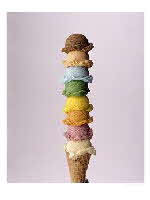See also: Food Safety Videos HOMEMADE ICE CREAM:
A Safe Summertime Treat?by Linda Bren Eating ice cream to beat the summer heat is one of America's favorite pastimes. And the rich, creamy flavor of homemade ice cream - whether it's made with an old hand-cranked ice cream maker or a modern electric one - is especially tasty.
But the gastronomical delight of homemade ice cream can give some people gastric distress -- or even worse -- a serious illness.
"Homemade ice cream is a special treat for many, but every year it causes several outbreaks of salmonella infection with up to several hundred victims at church picnics, family reunions, or other large gatherings," says John Sheehan, director of the Food and Drug Administration's Division of Dairy and Egg Safety.
The ice cream ingredient responsible for the outbreaks: raw or undercooked eggs. 
Between 1996 and 2000, the Centers for Disease Control and Prevention reported 17 outbreaks in the United States , resulting in illness in more than 500 people, that were traced to salmonella bacteria in homemade ice cream.
A person infected with Salmonella Enteritidis (SE), the strain of salmonella found most frequently in raw eggs, usually has fever, diarrhea, and abdominal cramps beginning 12 to 72 hours after eating or drinking a contaminated food or beverage. The infection generally lasts four to seven days, and most people recover without any treatment. But for those at high risk -- infants, older people, pregnant women, and people with a weakened immune system -- it can be life-threatening.
You can still enjoy homemade ice cream made with eggs without the side effects of salmonella infection by preparing it safely, says Nancy Bufano, an FDA consumer safety officer. "Just make sure you use egg products, egg substitutes, or shell eggs that are pasteurized," she says, "or use a cooked egg base."
"Egg products" are eggs that have been removed from their shells and pasteurized. Pasteurization is a heat process that destroys salmonella in eggs without cooking them. Egg products may be liquid, frozen, or dried whole eggs, whites, yolks, or blends of egg and other ingredients. Egg products are not widely available in retail stores; they are predominantly used in institutional food service. "Egg substitutes," which are also pasteurized, may be liquid or frozen and contain only the white of the egg, the part that doesn't have fat and cholesterol. "Egg substitutes are readily available and can be used in just about any recipe that calls for eggs, including ice cream," says Bufano. Shell eggs can also be pasteurized. "These eggs are not as widely available as egg products and egg substitutes," says Bufano, "but they are easily recognizable in the refrigerated dairy case at some stores." The FDA requires pasteurized shell eggs to be individually marked or specially packaged. Each egg must be marked to indicate that it has been pasteurized, or the carton must be shrink-wrapped or otherwise packaged so it's easy to tell if it has been opened before purchase, allowing for possible intermingling of pasteurized and unpasteurized eggs. Commercially manufactured ice cream is typically made with pasteurized eggs or egg products.
Unpasteurized shell eggs, the kind regularly found in grocery stores, also can be used to make ice cream as long as they are cooked properly. To prepare homemade ice cream this way, mix the eggs and milk to make a custard base and then cook to an internal temperature of 160 degrees Fahrenheit, which will destroy salmonella, if present. Use a food thermometer to make sure the mixture reaches the correct temperature, and resist the temptation to taste-test it during preparation when the custard isn't fully cooked. After cooking, chill the custard thoroughly before freezing.
Even when using pasteurized products, the FDA and the U.S. Department of Agriculture (USDA) advise consumers to start with a cooked base for optimal safety, especially if serving people at high risk. Additionally, make sure that the dairy ingredients you use to prepare homemade ice cream, such as milk and cream, are pasteurized.
Another option is to make eggless ice cream, says Bufano. "There are many recipes that don't call for eggs."
The same egg selection and preparation advice applies when making other foods with raw eggs, such as Caesar salad dressing, hollandaise sauce, mayonnaise, and eggnog. Commercially prepared versions of these foods are made with pasteurized egg products.
The FDA continues to work with federal and state agencies, the egg industry, and the scientific community to eliminate egg-associated SE illnesses. FDA Consumer magazine, July-August 2004
| 